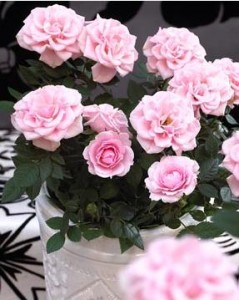
Features of growing hibiscus: why the Chinese rose does not bloom. Why the Chinese rose does not bloom and sheds leaves
Reasons why it does not bloom indoor rose, maybe several. Let's consider the main ones.
Lack of lighting. Roses are light-loving. Southeast or southwest windows are best suited for their maintenance. South-facing windows are less suitable, because in summer it is too hot for roses on them, and this causes plants to shrink leaves and flowers, which, moreover, fade and crumble faster. East and west windows are also suitable for growing roses, but if your apartment is facing north, these plants are best not to start. In your case, you can think about artificial lighting. In this light, many plants bloom beautifully, especially with fluorescent lamps. Even if there is no natural light at all, but there is properly organized artificial lighting, the plants will grow and can bloom well. Therefore, if the plant does not bloom, then, first of all, you need to think about whether it has enough light. You should also take into account the length of daylight hours, usually not less than 10-12 hours. The lamps above the plants are turned on when it starts to get dark outside until midnight. It is necessary to place fluorescent lamps at a distance not exceeding thirty centimeters from the tops of plants. Skillful use of highlighting allows you to keep your roses in bloom until winter, even until the New Year. Perhaps such additional lighting on the north and northeast windows will give its positive results, since plants also have problems on sunny windows, because on such windows, especially in summer, flower pots can be very hot by the sun. The earth in them dries up very quickly, and the roots of the plants overheat. Roses are very sensitive to such overheating, and in order to avoid it, it is better to choose light-colored containers for plants, and in the hot season (from May to September) cover the walls of the pots from the direct rays of the sun with white paper.
Wrong temperature. Roses categorically do not tolerate drafts: if it is not possible to find another place for a rose, make a small linen or paper screen around the plant at about half its height.
Incorrectly selected soil mixture. The rose belongs to the plants that love soil with a neutral pH of 6.5-7.5. a rose may not bloom if you plant it in soil with inappropriate acidity, or its flowering will be sluggish. Therefore, if your plant has enough light, sort out the soil - is it good enough for your plant.
Wrong transplant - one of the main reasons for the lack of flowering. At the same time, there can be many violations: too spacious or too cramped container; root damage can lead to the fact that even quite unpretentious plant does not bloom for a long time. Transplanting at the wrong time of the year, for example, in autumn or winter, is even fraught with the death of the plant.
plant malnutrition - this is not only when the plant is starving, if it has not been transplanted and fed for several years (perhaps it has been planted in very unfertile soil), but also when the plant has been fed too much fertilizer, especially if they are not properly selected and contain a lot of nitrogen (in such In some cases, they say - the plant "fats". The basic recommendation: it is better to "underfeed" the plant a little than, carried away by excessive fertilizer, salt the soil. The same can be said about the concentration of fertilizers used: it is better to dilute once again than burn the roots with too concentrated fertilizer mixture Don't try to change fertilizers from time to time, it's better to stick to a proven recipe.
Too dry air - can also be the reason for the lack of flowering. It should be noted that if the apartment has a high temperature - above 22 ° C, then periodic spraying only temporarily refreshes the plant, and this is not enough. Once a week, the leaves of a room rose should be washed or sprayed with water from a spray bottle. It is better to do this in the evening, after sunset. Between the pots, you can put vessels with water: it will slowly evaporate and humidify the air.
Pest infestation - oddly enough, but this is not the most common reason for "non-blooming" of plants, but nevertheless, with a very strong lesion, the plant not only grows and develops poorly, but also does not tie buds. If the pest did not have time to spread strongly on the plant, then it may bloom, but then it will begin to lose both buds and flowers.
There are other reasons why the plant does not bloom. It may or may not be the correct cut.
Also, one or more of the above factors may be the cause of yellowing of the leaves.
If there are no pests on the leaves of roses and the plants do not have diseases, then the yellowing of the leaves of the roses may occur due to a deficiency of nutrients.
Rose leaves become pale green and yellow from the midrib with a lack of nitrogen.
Yellowing and spotting of rose leaves is observed with a lack of potassium, yellowness between the veins of the leaves occurs with a lack of iron.
The leaves of roses can also turn yellow with excessive overfertilization, so fertilizer doses must be observed.
If you did not fertilize the plants in time, then the abundant flowering greatly depleted them, which led to the yellowing of the leaves. In this case, fertilize the rose with a complex fertilizer. You can additionally sprinkle the leaves with "Epin" or "Silk" to support immunity.
For the prevention and treatment of chlorosis (signs of the disease: yellowing of leaves with green veins, yellow spots on the leaves), water-soluble fertilizer "Iron Chelate" (antichlorosin) is used. Watering or spraying chlorotic plants with this preparation is carried out twice during the growth period, and then, if necessary, every two weeks. 
As you can see, there may be several reasons for both ailments of your rose. Therefore, simply analyze the conditions of detention and care for the rose, and based on this, choose a rescue plan.
You can read more about the problems of indoor roses at the links http://greenhome.org.ua/uxod-za-komnatnymi-rozami, as well as a lot of material about indoor roses on the site
Ornamental plant Chinese rose is also called Chinese rose, Hibiscus Chinese (lat. Hibiscus rosa-sinensis); is one of the species of the genus Hibiscus (lat. Hibiscus) of the Malvaceae family (lat. Malvaceae). Of the 300 - 500 currently known species of plants from the genus Hibiscus, this species is most often cultivated in indoor and greenhouse floriculture. The entire Malvaceae family is classified in the order Malvotsvetnye. The flowers of this family, including the Chinese rose, have nothing to do with roses. The real Rose (Rosehip) is included in a different order - the order Rosaceae (lat. Rosales).
The plant is native to Southeast Asia.
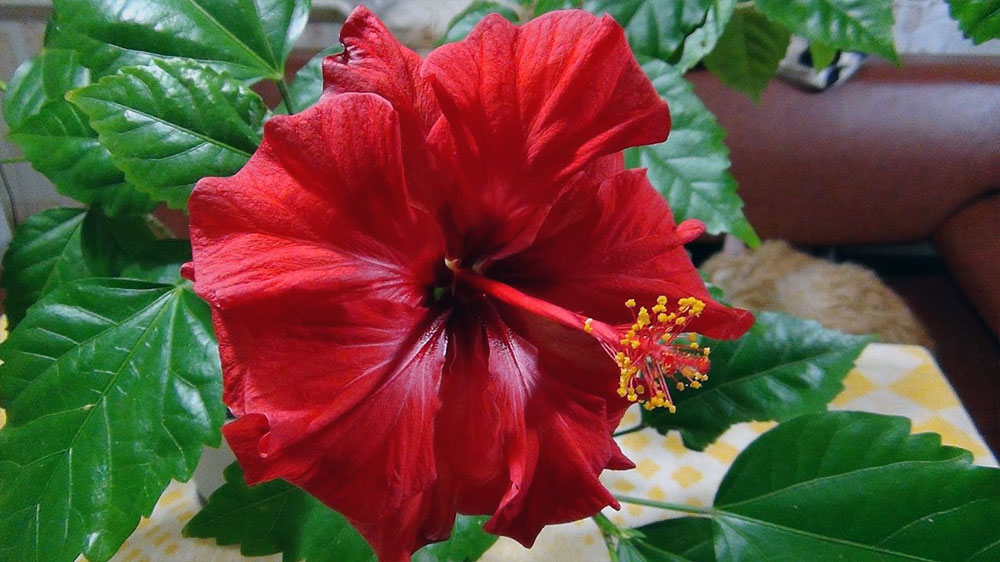
The life forms of the Chinese rose are woody plants: in nature they are trees and shrubs up to 4 m high, in indoor floriculture conditions they are compact trees with a lush crown and elegant shrubs up to 1.5 m high.
The leaves are large, oval or obovate on long petioles, shiny, smooth, dark green or bright green in color (they can also be variegated - with creamy or pinkish veins-stripes, edging). The type of leaf edge is serrated. The shape of the base of the leaf plate is rounded. The arrangement of the leaves is another. The large leaves of this shrub effectively purify and regulate the composition of gaseous substances in indoor air. The leaf blades, covered with sticky juice, cope with the function of a reliable dust collector.
The flowers are simple bell-shaped, double and semi-double, in diameter they can reach 15-25 cm. There are plants with a wide variety of flower colors.
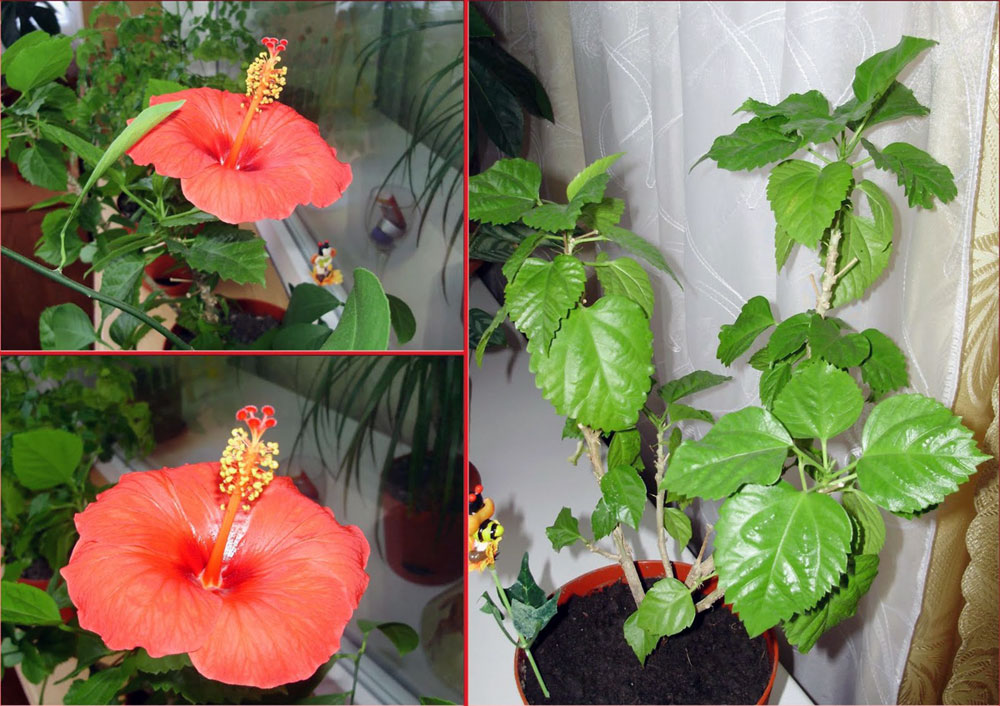
Flowering is plentiful, from March to October, the flowering of each individual flower is short-term, no more than 48 hours, then the luxurious flowers fade, they are replaced by new ones. The plant is low allergenic: the aroma has a subtle smell, the pollen of Chinese rose flowers does not spread through the air.
![]()
Chinese roses at home usually live for a long time, several decades. Plants withstand cold, drafts, darkness, sunburn. The Chinese rosan endures for a long time, endures numerous flaws in its care, and then begins to slowly act up - it will drop the buds, then it will bloom at half strength, or it will stretch out into something clumsy or completely stop blooming.
Both insecure novice flower growers and experienced amateurs who know how to surround the Chinese rose with care, bewilderment arises from time to time: “Why doesn’t it bloom with me?” Chinese rose? It blooms at the post office, in the clinic, in the office hall, but not in my cozy apartment.”
You can write down a very long list of reasons. The primary reason is ignorance of the characteristics of this plant, ignoring the main phases of its life cycle.
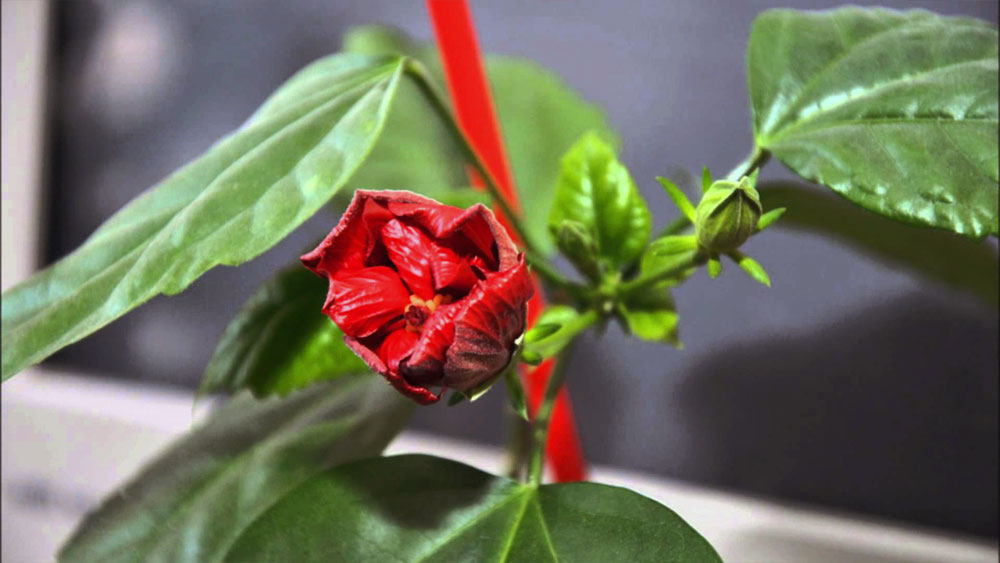
Spring and summer for the Chinese rose are the periods of the beginning of the life cycle and flowering, the phase of active growth. A well-groomed shrub or Chinese rose tree at home can bloom from March - April until the beginning of winter. For the harmonious development of the plant during this period, the following recommendations must be followed:
- keep the plant at a temperature of 20 - 25 ºС;
- choose a permanent place for the plant and do not move from place to place; make a "light mark" on the planter to take into account the angle of incidence of the sun's rays;
- when choosing a place, stop at bright, adequately lit corners of the apartment protected from drafts and wind;
- protect the future beauty from bright direct sunlight;
- in early spring, before waking up (in February), do a gentle pruning, later - pinching to form a beautiful lush crown near the tree;
- every year at the beginning of spring, transplant the Chinese rose into larger pots; use moisture and breathable slightly acidic (pH 6.8) soil structured with sand, soddy soil, leaf humus;
- water the plant abundantly early in the morning, after 1 - 2 days, do not allow water to accumulate in the pan;
- periodically loosen the top layer of the soil substrate between waterings;
- with a high concentration of buds, especially in the case of young plants, remove about one in four to avoid dropping them;
- during the flowering period, regularly (1-2 times a week) apply aqueous solutions of complex mineral fertilizers;
- when buying fertilizers, keep in mind that the optimal fertilizer formula for Chinese rose is NPK=9-3-13; 10-4-12; 12-4-18 (NPK means nitrogen, phosphorus, potassium); fertilizers for flowering plants not suitable for this plant; the composition of the “Universal fertilizer for potted plants” with NPK = 7-3-7 manufactured by POCON is closer to the optimal formula;
- to eliminate magnesium deficiency, use Epsom salts or Siliplant fertilizer, or Greenwold fertilizer for conifers, containing 3% nitrogen, 2% potassium and 5% magnesium oxide;
- carry out top dressing on hot days, on a previously moistened coma of the earth (note that it is impossible to feed a recently transplanted plant);
- carry out foliar top dressing (spray the leaves in the morning or evening with diluted formulations with a low concentration of nutrients);
- in case of heat, dry air, spray the plant with water at room temperature;
- refresh, rub Chinese rose leaves to improve respiration and photosynthesis.
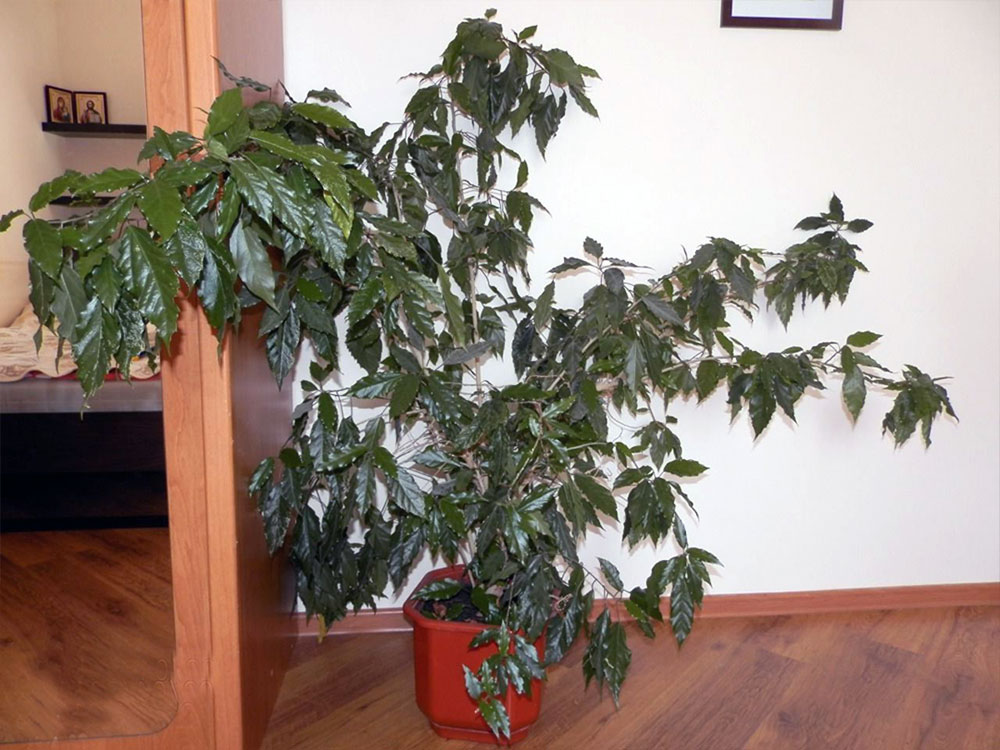
Chinese rose care in autumn and winter
Autumn and winter are periods of rest for the Chinese rose. In autumn, flower buds are laid, the most favorable temperature for this is about 15 ºС. In winter, in conditions of lack of heat and light, the plant is in a state of hibernation, resting. During the off-season, the following recommendations should be followed:
- prune the plant in October after the end of flowering (remember: flower buds appear only on young lateral branches);
- maintain a temperature of 13 - 16 ºС, optimal for the plant during this period;
- find for the plant for this period the coolest (it can be shady, but not in a draft) place in the house;
- do not disturb the plant with frequent watering, spraying and fertilizing, water it so that the earthen ball does not simply dry out completely,
- in February, wake up the plant: move it to a warm place, increase the frequency and volume of watering.
Add site to bookmarks
Features of growing hibiscus: why the Chinese rose does not bloom
- Shrub of the Malvaceae family
- care mistakes
- Possible problems and diseases
Hibiscus is one of the most beautiful evergreen shrubs. Novice flower growers love him for his unpretentiousness.
The Chinese rose is an unpretentious evergreen shrub that pleases the eye with large bright colors.
Why won't China rose bloom? The reason for this is a change in growing conditions and negative factors that affect a fairly disease-resistant houseplant.
Shrub of the Malvaceae family
Hibiscus is native to northern Indochina. Over time, the shrub began to spread in regions with a tropical and subtropical climate, it began to be grown in park areas and gardens. For 8 months, he continuously pleases the eye with a scattering of white, orange, yellow, crimson and scarlet inflorescences.
Chinese rose is grown in harsh and temperate climates, in greenhouses and apartments. Experienced and novice flower growers love the rose for its combination of unpretentiousness with an extraordinary decorative effect. The sharp color contrast between the glossy dark green foliage and vibrant flowers is a real delight.
![]()
The optimum temperature for hibiscus to bloom is 15°C.
The shrub has a lush crown, which, with proper care, can reach a three-meter height. Funnel-shaped flowers, large, up to 15 cm. Terry, semi-double flowers bloom for a long time, and keep open only a few days.
The plant is light and moisture-loving. If the earth dries up, the Chinese rose sheds its leaves. In order for the plant to feel good, it must be regularly sprayed and placed on a tray with water. Roses tolerate light partial shade well, but in this case they will bloom less. Indoor Chinese rose blooms from early summer to autumn.
Large funnel-shaped flowers are held on a long pedicel. The inflorescence is formed from five petals, collected in a tube around a golden stamen. Flowers bloom at dawn, and by sunset, the petals begin to fall. Many varieties are odorless, only some white inflorescences spread a subtle and delicate aroma. A medium-sized shrub can produce up to 20, and a large plant - up to 50 inflorescences.
Back to index
care mistakes
For beginner gardeners, indoor roses may not bloom for a long time. This suggests that there are flaws in the care and the hibiscus got sick. It can be attacked by aphids, whiteflies, thrips, scale insects. They affect the tissues of the plant: the leaves begin to turn yellow and the buds that appear fall off. To protect the flower, insecticides are used to treat the plant.
There are several factors that will have a positive effect on hibiscus flowering:
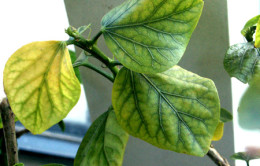
The plant may not bloom due to the defeat of its aphids, scale insects, whiteflies.
- The room temperature should be around 15°C.
- Infrequent watering.
- Small penumbra.
Such conditions are often observed in office and public buildings. Roses are in full bloom there. It is not always possible to maintain such a temperature in houses and apartments. If a room rose is provided with complete rest from the beginning of autumn to the beginning of spring, then colorful flowering will be guaranteed. From mid-February, as a rule, young leaves appear on the shrub. This suggests that the plant begins to wake up after a winter rest.
From now on, the pot needs to be rearranged to a brighter place and begin to gradually add fertilizer, water more abundantly. If the first buds appear, then when changing places, the hibiscus can drop them. If the leaves turn yellow, the buds fall off, this is a consequence of the fact that the content of chlorine and calcium is exceeded in the water for irrigation. To reduce their amount, water must be defended for at least a day.
It is important to properly water the flower. At any moment, all beauty can be violated precisely because of improper watering:
- The water must be soft. When using it, no scale remains in the kettle, and a film does not float on the surface of boiled water.
- For irrigation, water must be well defended so that there are no traces of chlorine in tap water.
- The water temperature should be around 30 degrees.
In summer, indoor hibiscus is plentiful and spray leaves from a spray bottle. But between watering, the top layer of the earth should dry out. In winter, the plant is rarely watered. In cold, damp soil, inactive roots can rot. Lack of watering or nutrition will cause buds and flowers to drop when the hibiscus blooms.
For flowering are especially effective. It can be an extract from superphosphate, or a special composition for indoor flowering plants. Fertilizers are applied only to moist soil.
What to do if hibiscus does not bloom and how to find the reason. Rosan should not be overexposed in cold conditions. In order for it to bloom, it is necessary to exclude temperature drops during the growing season. So, if the plant is kept in the cold until the buds appear, and then transferred to heat, the buds will fall off from a sharp change in temperature. The same will happen if the plant falls under a draft.
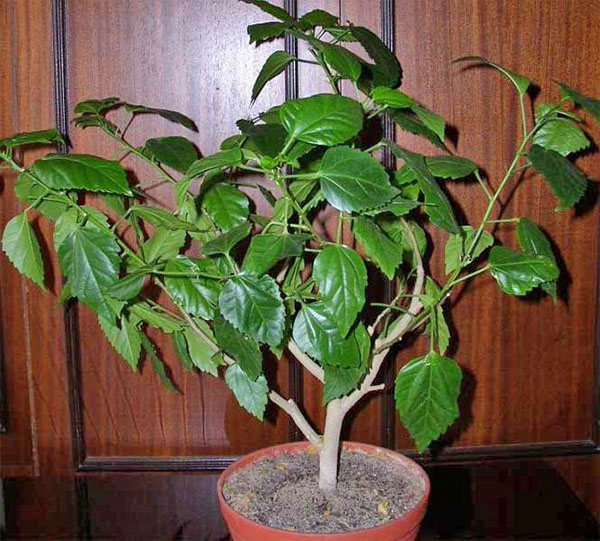 A flowering tree requires careful handling. The pot is installed in place once for the whole summer. It cannot even be turned if the buds are already dialed. The peduncle is very loosely attached and falls off from the slight swaying of the twig. Therefore, during flowering, you need to walk past carefully.
A flowering tree requires careful handling. The pot is installed in place once for the whole summer. It cannot even be turned if the buds are already dialed. The peduncle is very loosely attached and falls off from the slight swaying of the twig. Therefore, during flowering, you need to walk past carefully.
Hibiscus love fresh air in summer. You need to install flowerpots in a place protected from wind and direct sunlight. A loggia, balcony or veranda with a sun curtain will be the best place for blooming hibiscus.
Why hibiscus with yellow leaves does not bloom
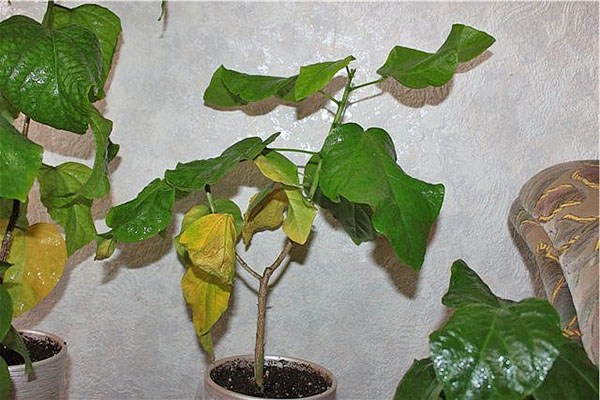 It should be noted that only healthy hibiscus bloom, which have the necessary conditions for development. If spots appear on the leaves of any size or the leaf blade turns yellow, these are signs of the disease. So, green drooping leaves will say that the plant is dry, then it will shed its color and buds.
It should be noted that only healthy hibiscus bloom, which have the necessary conditions for development. If spots appear on the leaves of any size or the leaf blade turns yellow, these are signs of the disease. So, green drooping leaves will say that the plant is dry, then it will shed its color and buds.
Yellow leaves can give a signal that there is a disorder with the root system, and it is not necessary to wait for flowering in these conditions. In addition, insect pests can colonize the plant, taking food from the hibiscus. Therefore, each pruning, watering, wiping the leaves should be combined with a routine inspection of the plant.
Compliance with agricultural technology will allow you to enjoy the victorious flowering of a tropical plant every year, which brings harmony to the house in relations between family members.
Hibiscus care experience - video
Diagnosing problems with plants is akin to diagnosing diseases in humans - that is, this is not an easy task and requires experience. Still, let's try to understand and describe all reasons, according to which the indoor rose does not fulfill its main purpose - it does not give abundant and beautiful flowering.
Why does the indoor rose not bloom?
The main reasons for the lack of flowers:
- Little light.
- Unsuitable soil.
- Indoor climate.
- Lack of nutrition.
- Excess food.
- Wrong shaping.
- Diseases and pests.
Let's consider each reason in more detail:
Light
Roses are light-loving plants. The best window for a room rose is southwest or southeast. The east window is also acceptable, but you should make sure that the variety is not the most capricious. South windows are acceptable only if they are not too hot - roses in the heat shrink flowers and leaves, and flowering is not so long. Analyze your own conditions. The south window to the south window - discord. Maybe there is a tree in front of your window, and the window itself is on the ground floor, so even on the south window home rose maybe not enough light.
If the rose does not have enough light, or the apartment has only northern windows, you can arrange illumination with artificial light. Roses thrive in this kind of lighting, if, of course, it is chosen correctly, and besides, a modern choice allows you to arrange it without compromising the design of the room.
The length of daylight needed for a rose to bloom should be 10-12 hours.
Perhaps the rose has enough light, but bright the sun's rays heat the pot too much(especially dark plastic pots) and the soil dries out, heating the roots. Rose roots still love relative coolness. Therefore, it is better to immediately plant a rose in pots of light shades, or organize shading near the pot.
Wrong soil and transplant
Roses to taste the soil with neutral acidity. Inappropriate acidity leads to the absence of flowers, or to their impoverishment. To check the acidity of the soil, it is enough to buy a special indicator, it is inexpensive and is sold in almost any store for flower growers. Acidity should be at a pH level of 6.5-7.5.
It is also worth paying attention to soil mechanical properties. Many do not attach importance to this, and this is one of the key factors in moisturizing and nourishing the plant. The soil can retain moisture too much, combined with the coolness of the room, this contributes to the souring of the roots and fungal diseases. Or, on the contrary, the substrate may be too loose, water and breathable (purchased soils with a high peat content are often guilty of this) - a rose in such soil will regularly dry out, especially if it is hot in the room.
In our practice, there were similar cases - too small a pot and heat, such a rose had to be watered several times a day, and still the hostess did not have time, the plant regularly turned yellow and flew around the lower leaves, it did not grow well and, of course, could not bloom - transplant in a larger pot and more nutritious, dense, moisture-intensive soil solved the problem.
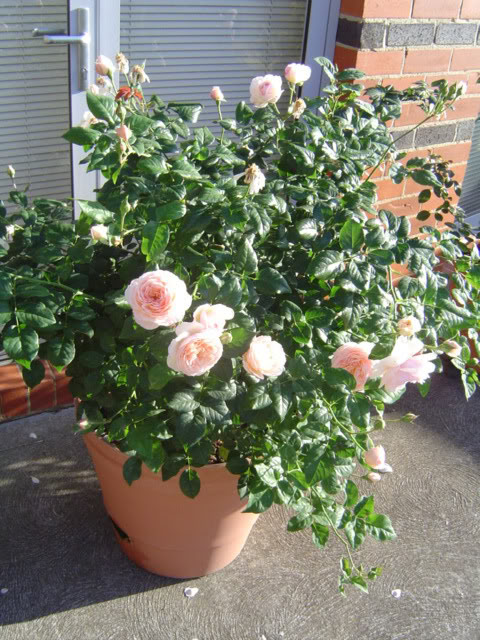 note for pot size- too cramped, too spacious, the plant has recently had a transplant, did it have to be transplanted at the wrong time (autumn or winter)?
note for pot size- too cramped, too spacious, the plant has recently had a transplant, did it have to be transplanted at the wrong time (autumn or winter)?
Don't wait for flowers from a freshly transplanted plant, even if it releases buds. Would need 1-2 months for adaptation and restoration of the root system, it is better not to overload the plant and remove the buds.
Many are in a hurry to transplant a rose immediately after purchase, knowing that the soil in which the plants are sold is not entirely suitable for their permanent habitat. It is not always worth rushing with this, look at the state of the flower. If the rose is healthy and seems to be doing well, it is worth giving it time to acclimatize to new conditions for several weeks, and only then proceed with the transplant.
Climate
In rooms, as a rule, the temperature is acceptable for a rose, but this culture perceives temperature drops during drafts extremely painfully, even in open ground roses are recommended to be planted in places protected from the wind. If the apartment does not have a place convenient for the rose without drafts, you can organize protective fences - it is enough to protect the plant at half its height.
Another common problem - dry air - is solved by spraying the plant daily or every two days. At temperatures above 22 °C, spraying is not enough. You will need to do any of the following:
- Shower for plants- carried out once a week, the leaves are washed abundantly in the shower, with low pressure, the water is selected at a comfortable temperature. The procedure is best done in the evening.
- Can be purchased special humidifier. For a rose, the optimal humidity level is 70-85%, which is slightly higher than the humidity that is comfortable for a person (60%), but nothing prevents you from combining different methods of moisturizing, including those local to the plant. For example, an air humidifier operates in an apartment, creating a humidity level of 60%, a rose is sprayed every other day - this will be enough.
- Sometimes there are recommendations arrange water containers nearby- not the best way, it is better to put the plant in a bowl with wet peat.
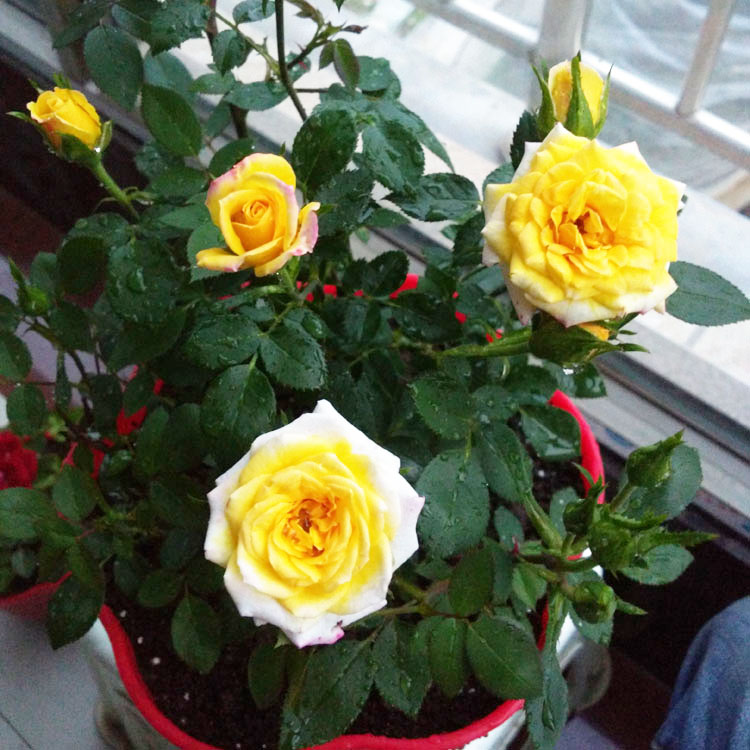 Roses are reluctant to bloom in the heat. If the temperature is above 28 ° C, the processes of photosynthesis slow down, the flower consumes moisture only for the purpose of cooling. Accordingly, the leaves and buds do not receive enough nutrition. First of all, of course, flowers suffer. Therefore, in hot summers, weaker flowering can be expected. Ideally, of course, to observe a strict temperature regime during the budding period, with a decrease in daytime temperature to 15-18 ° C, and night temperature to 15 ° C, these are the rules that are observed in industrial cultivation. However, it is difficult to organize such conditions in an apartment, just remember that a hot loggia or balcony, even facing, for example, to the southeast, but heated up during the day under the scorching rays of the sun to a temperature of 30 ° C, is not the best place for blooming roses. Or, at least, it is worth providing the plants in this case with sufficient humidity - above 60%.
Roses are reluctant to bloom in the heat. If the temperature is above 28 ° C, the processes of photosynthesis slow down, the flower consumes moisture only for the purpose of cooling. Accordingly, the leaves and buds do not receive enough nutrition. First of all, of course, flowers suffer. Therefore, in hot summers, weaker flowering can be expected. Ideally, of course, to observe a strict temperature regime during the budding period, with a decrease in daytime temperature to 15-18 ° C, and night temperature to 15 ° C, these are the rules that are observed in industrial cultivation. However, it is difficult to organize such conditions in an apartment, just remember that a hot loggia or balcony, even facing, for example, to the southeast, but heated up during the day under the scorching rays of the sun to a temperature of 30 ° C, is not the best place for blooming roses. Or, at least, it is worth providing the plants in this case with sufficient humidity - above 60%.
nutritional deficiency
One of the frequent complaints is “the rose is turning yellow and the leaves are falling off - what’s the matter?” may be due to nutritional deficiencies:
- Pale shade of leaves along the midrib, young leaves are too light, leaves fall off, shortened shoots, poor growth, weak flowering or its complete cessation - lack of nitrogen. It is worth carrying out foliar feeding.
- Gradual yellowing between the veins(veins and a small area along them remain green) - this is chlorosis, iron deficiency.
- Spots and yellowing of the leaf plate between the veins, the veins themselves are bright green - a lack of potassium.
- Rarely found yellowish spots with a burgundy tint and sagging is a lack of phosphorus.
Fertilizers should be treated especially carefully shortly before flowering, during the laying of buds and - a moment that many people forget - after flowering. It is likely that the reason for the lack of flowers in the rose is that she exhausted her strength last time and now simply cannot recover.
Why else can leaves turn yellow and fall off?
In addition to the lack of nutrients, there are three main reasons: diseases, overflow, underfilling. The first one is discussed below.
underfilling- the problem is obvious: drying soil and drying, yellow lower leaves that fall off, while the petiole is dry, and the tips of such leaves began to shrivel. This problem is often confused with another one, soil jamming. When the roots get wet and overwatered (perhaps the plant is planted in too dense soil), the roots begin to die, the leaves lack nutrition, they turn yellow, but a little differently than during drought. They are like lose their tone, become soft(and not fragile), fall off without losing elasticity, that is, the petiole of the fallen leaf will be soft to the touch.
A flooded plant needs urgent resuscitation (removal of rotten roots, processing, planting in fresh soil, careful observation and care), otherwise it will completely die in the near future.
excess nutrition
Oddly enough, this is a more common problem than a drawback. Novice flower growers often start taking care of the plant too hard, and as a result salt the soil. You should also monitor the dosage of fertilizers - do not exceed the concentration indicated in the instructions, and even better to reduce. Fertilizer should be watered correctly - the soil must first be slightly moistened.
Signs of overfeeding? Lush greens - with excess nitrogen, the plant fats, begins to go into the "tops". You can also determine overfeeding if the rose is disease-prone, does not grow well, while the rest of the points of care are in order.
Wrong shaping
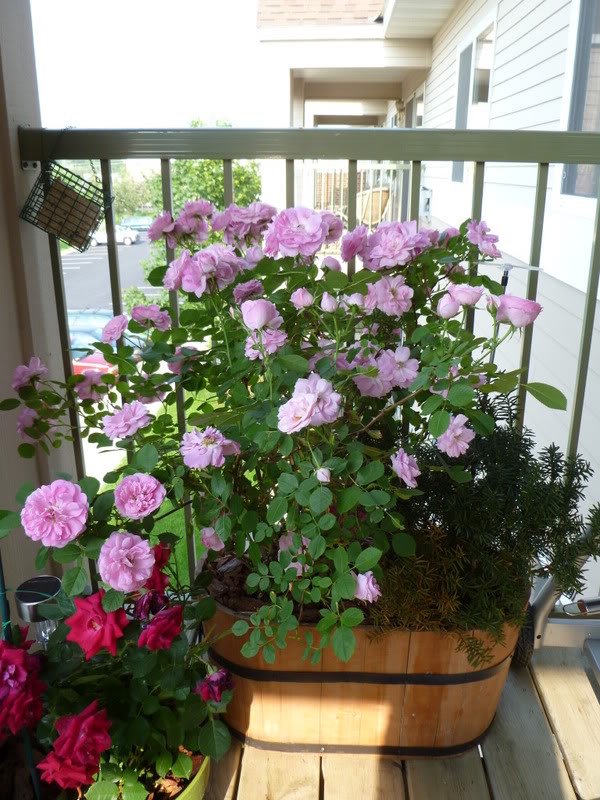 Flowers are located on stems, so the quality of future flowers directly depends on their strength and quality. Pruning for lush flowering is necessary for all roses, including indoor roses (usually indoor roses are Polyanthus, Floribunda, Chinese - they all accept pruning gratefully).
Flowers are located on stems, so the quality of future flowers directly depends on their strength and quality. Pruning for lush flowering is necessary for all roses, including indoor roses (usually indoor roses are Polyanthus, Floribunda, Chinese - they all accept pruning gratefully).
The most important - pruning term. It is carried out in the spring - when the plant enters a phase of active growth (determined by swollen buds), in addition, it is important to take into account the light regime and plant nutrition. If daylight hours are too short, the shoots will stretch out and be weak, unable to produce abundant and large flowers. Too late pruning, when the plant has already directed its forces to the growth of existing shoots, will be too energy-consuming for the culture, and as a result, such a flower will begin to lag behind in growth.
Before pruning, you should make sure that the plant in the room will be provided with at least 10 hours of daylight - if less, the shoots will inevitably stretch out and you will not have to wait for lush summer flowering.
Diseases and pests
One of the most common reasons for the lack of flowers. A rose is a crop that is not too adapted to room conditions, therefore it is often affected by pests. Especially strongly their appearance is promoted by dry air and insufficient moisture. The most frequent problems:
- Spider mite. Faced with it, without exaggeration, almost all rose growers. Ticks do not always notice the rhinestone, it appears on the underside of the leaves in the form of small reddish dots. On young shoots you can see white dots - larvae. The method of struggle is treatment with drugs ("Fitoverm", "Strela", "Neoron", "Diazanon" or "Aktellik", "Vertimek", "Akarin", "Agravertin"). Prevention - maintaining optimal humidity. non-flowering plants that do not have decorative value, for example, in winter, can be kept in special mini-greenhouses.
- Shield and false shield- look like brownish plaques. The methods of struggle are similar to those described above, with a spider mite. You can clean it by hand, but it will take persistence. A combination of methods is effective: bathing, manual cleaning, Fitoverm.
- Rose aphid. Light green insects, usually themselves clearly visible, as well as the results of their activities (the plant is deformed, covered with spots, punctures, characteristic plaque, leaves and buds fall off), multiply very quickly. They can get into the house with other plants, with drafts, when transplanted into contaminated soil, and even “arrive” on pet hair. Both insecticides and folk remedies(mustard powder, garlic-soap solution, orange peel infusion, etc.).
- powdery mildew- a frequent scourge of indoor roses. A grayish coating, as if covering the shoots, leaves and buds - this is exactly it. All parts of the plant covered with such a powder are mercilessly removed, the plant is treated with fungicides or other antifungal drugs. One of the reasons for the appearance of diseases is too sharp changes in day and night temperatures.
- In conditions of high humidity, the rose can be struck and other fungal diseases. It does not make sense to delve into their names, however, if it is hot and humid, dark, as if weeping spots are visible on the leaves, the leaves turn yellow, fall off - the rose is affected by the fungus. All infected leaves and parts of the plant should be removed, sprayed with a fungicide.
- Viral diseases- These are yellow stripes or spots, they are easy to recognize because there is some geometry in their pattern. Affected plant parts better plant wholly to be destroyed. There are no chemical treatments.
the best disease prevention is proper care . Especially temperature and humidity conditions. At air humidity of more than 90%, roses begin to get sick with powdery mildew, above 95% - with gray rot, downy mildew, ordinary powdery mildew, at humidity less than 50% - plants are easily affected by powdery mildew and spider mites.
Periodically, it makes sense to spray indoor roses with preparations to maintain immunity: "Epin", "Zircon".
Question answer
How often do house roses bloom?
This depends on the type and variety. There are varieties that can really bloom almost all year round, excluding the rest period (it can be artificially reduced). But, as a rule, a room rose bought in a store will bloom at best from May to November, or several times a year (2-3 times).
Roses bloomed all summer, in September the leaves became very weak, the plant grows poorly, the leaves grow and fall off, it is already January, and the rose still looks bad. Doesn't bloom. What's the matter?
It's simple: many novice flower growers, seeing a rose in a pot, for some reason begin to think that its content is similar to many other, evergreen, indoor crops. But roses are deciduous, they need a rest period. For wintering, roses are placed in a bright and cool place, watering is reduced (only so that the soil does not dry out to a state of dust) and left alone - just inspecting the plant is enough, falling leaves are normal. In the spring - transplant, cut, a week after transplantation light top dressing.
What to do? The rose dries, the leaves fall off, the buds appear, but not enough, they also fall off, some shoots withered???
Seems to be, the plant is overdried. All dried branches should be cut, leaving a length of 3-4 cm, water the plant, but moderately, and cover with a plastic bag. Put this makeshift greenhouse in a bright, moderately warm place. As soon as new shoots have appeared, you should begin to accustom the rose to fresh air.
I accidentally dried out the rose, the leaves withered, but did not fall off, what should I do?
You can try to "soak" the plant. If the pot is made of unglazed ceramics, you can completely dip it in water and let the rose stand like that until the pot itself and the earthen lump are completely wet. Put the plant in a plastic pot in a deep pan, water it well, wrap it in a plastic bag, leave for 1-2 hours, after which time the leaves will restore their turgor.
I water normally, without overflow, but the rose dries and the lower leaves fall off, the buds do not appear at all, some shoots dry, what could be the matter?
Probably, the pot is too small and the rose does not have enough nutrition, it is worth transplanting the plant. Only by the pass method, so as not to damage the root system, otherwise flowering will not have to wait soon.
How to make an indoor rose bloom?
In general, if the rose is properly cared for, you don’t need to force it - it will bloom. In addition, there are varieties that can bloom almost all year round with very few interruptions. You should choose own-rooted roses (however, all indoor specimens should be like that, although this is not always the case), with bright green, stain-free leaves. After flowering, it should be cut short, provide a dormant period at a fairly cool temperature - roses devoid of such a period either bloom poorly or do not bloom at all.
What to do if the rose has stopped blooming?
Autumn is a natural process the plant goes dormant. If this happened in a different period, all the reasons described above should be analyzed.
Is it possible to transplant a blooming rose in a pot?
Theoretically possible, but not very clear, why risk the flowering of the plant? In any case, even a gentle transplant, or transshipment, is stressful for the plant, and, most likely, all the buds of such a flower will fall off. If there is a desire to see a rose in a more beautiful container, it is not necessary to transplant, you can simply put it in such a container.
How to achieve abundant flowering of a room rose?
Proper care, top dressing, a rest period is a must, and, of course, the right choice of variety, not all varieties, even with good care, will be completely covered with flowers.
How to water roses so that they bloom?
As for water, it is watered only with settled (at least a day) water, it is better to collect rainwater, in winter it is best to melt or just put snow in a pot. As for fertilizers from root dressings, the following can be recommended:
- urea solution(spring, immediately after pruning, this will give the plant the nitrogen necessary to gain green mass),
- solution of ash, mullein, chicken manure, horse manure, saltpeter, potassium magnesia, extract from banana skins(these are potash fertilizers, they are used in June for abundant budding),
- universal mineral fertilizers, for example, Kemira, or nettle infusion, or organic matter (manure, compost, litter) - they are applied after flowering is completed so that the plant regains strength.
- organic fertilizer, or fertilizer based on phosphorus and potassium(in last month summer, before wintering)
Do not feed during flowering! In each of these four cases, one type of fertilizer is chosen. Watering with fertilizers no more than 1 time in two weeks, and, of course, you need to focus on your own conditions and the well-being of the plant.
Can give good results watering with a sugar solution (for 1 glass of water 2 teaspoons). Roses during the growing season are watered with this solution 1 time per week, weakened - 1 time in five days.
Why does a purchased rose dry?
Purchased roses in pots often begin to dry. If nothing is done, it will gradually lose all the leaves, and may even die. What can be done? The answer to this question is from the Garden World blog.